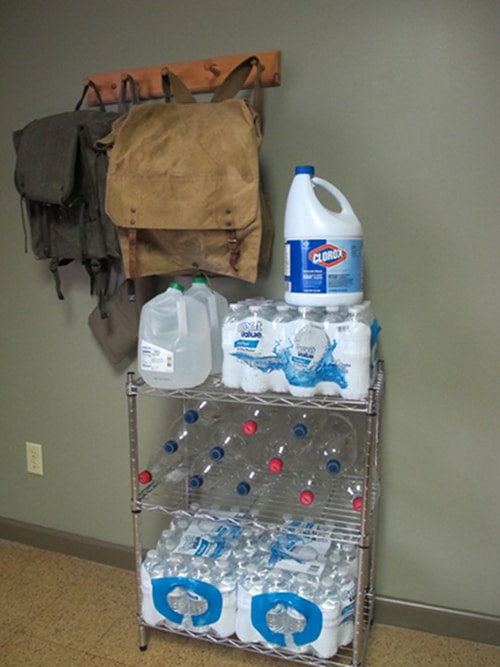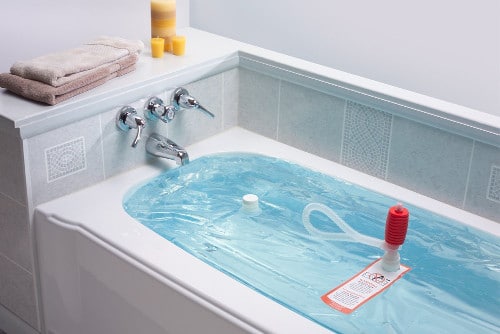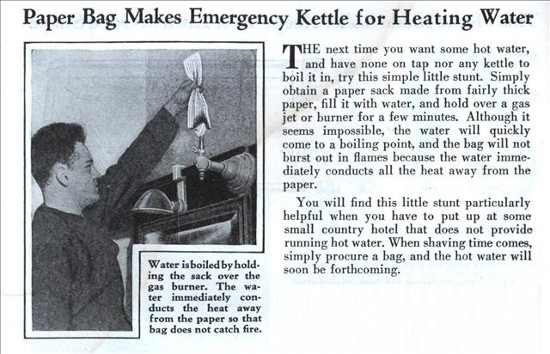April 1, 2014
Manly Skills, Self-Reliance, Survival
A big storm and earthquake hits your town. It’s a certifiable quakenado.
Your house is spared structural damage, but the power and water are out. According to news reports, the grid is down in your area and several water mains are broken. Conservative estimates are that it will take crews at least a week to get water service back on.
Would you have enough water in your home for you and your family to last until the water came back? Or if you live in the southwest, would you have enough in a situation where your city just plain runs out of water?
How Much Water Do I Need?

Water…because ducking and covering works up a mighty thirst.
The general rule of thumb is that you’ll need one gallon of water per person per day. Half a gallon is used for drinking and the other half is used for hygiene. That number will go up depending on a whole host of factors. If you live in a hot climate or have pregnant or nursing women in your group, you’ll want to store more water.
Alright, so a gallon a day per person is the general rule.
So the question becomes, how many days without water should you prep for?
Well that depends on how prepared you want to be for varying degrees of disaster.
FEMA recommends that everyone have enough water to last three days should your regular water source be disrupted. Three days of water should be enough to get you through the periods of water shut-off or contamination that can happen during natural disasters like earthquakes, tornadoes, and ice storms.
Three days is a good starting point, but even during run-of-the-mill disasters, water access can be down for much longer than that.
After spending hours reading prepper blogs and forums, it seems the general consensus is that you should have at least two weeks worth of water on hand. So for a single person, that’s 14 gallons of water. For a family of four, that would mean you’d need 56 gallons of water.
Whether you decide to go above and beyond the two-week minimum is up to you. For lots of people, finding space in their home or apartment to store enough water for two weeks is a stretch, so trying to find room for a month might not be in the cards (though with a bit of creativity, you’d be surprised how you can arrange things in your house to make room for large amounts of water and food storage). Even if space isn’t an issue, the upfront costs for long-term water storage can be prohibitively expensive.
My recommendation would be to start off with the two-week supply and slowly build up to larger amounts as space and money become available. Right now I have about a month’s worth of water for my family. The funny/scary thing about prepping is that it can become a weird obsession. Once I filled my two 55-gallon barrels with water, I immediately wanted more. Now I’m shooting for a year supply. Have I turned into a crazy SHTF (Sh*t Hits The Fan) prepper? Just a touch. I better get busy burying 42 school buses underground….
Long-Term Water Storage Solutions
So you’ve decided to start building your emergency water supply. You’ll need a safe container in which to store it. The general guideline is to use food-grade plastic bottles. You can also use glass bottles so long as they haven’t stored non-food items. Stainless steel is another option, but you won’t be able to treat your stored water with chlorine, as it corrodes steel. Finally, no matter what you store your water in, make sure you can seal it. You don’t want any bacteria or other contamination mucking up your drinking water. Below, we highlight several water storage options.
Two-Week Water Storage Options

Store-Bought Bottled Water. The easiest (but slightly more expensive) way to reach your water storage quota is to simply buy pre-packaged bottled water. It’s clean, well-sealed, and comes in food-grade plastic bottles. Moreover, bottled water is highly portable, which comes in handy ifyou need to bug out. This is a great option if you have limited space in your home or apartment. Just buy a bunch of packages and store them under beds. For example, one 35-count package of Poland Spring waterprovides about 4.6 gallons. That’s enough water to last one person four days. If you want two weeks of water, you just need four packages.
Empty Soda/Water/Gatorade Bottles. If you’re a cheap bastard, you can just refill empty soda/water/Gatorade bottles with water from your tap. Just make sure to thoroughly clean the bottles first, using this process.
5-7-Gallon Water Jugs. If you’re a regular camper, you might already have a few of these in your garage. They’re made from sturdy, food-grade plastic. The plastic is usually a dark blue which restricts light and helps prevent algae growth. I think the blue is also to remind you that “Hey! This is for water only!” The jugs are typically stackable, so they make for easy storage, even in the tightest of spaces. Their smallish size also makes for easy transport in case you need to leave your home base.
One Month or More Water Storage Options
waterBOB. If you’ve read The Road, you’ll likely remember the scene where our protagonist begins to fill up a bathtub immediately after seeing flashes that signal an impending apocalypse outside his window. He knew the city water would be shutting off soon, and he wanted to store as much as he could before that happened. This is actually in my emergency plan if we ever encounter a SHTF moment here in Tulsa. While filling up a tub will give you 100 gallons of water, the problem is that it’s not very sanitary for a couple of reasons. First, when was the last time you cleaned your tub? And if you did clean it recently, did you use harsh chemicals to do so? Either way, you probably don’t want to drink water straight from it. Second, water in your tub has no covering so it’s susceptible to all sorts of contamination.

In times of crisis, a waterBOB is quite handy. Be sure to have fresh towels and some scented candles on hand as well, as seen above. Even during the apocalypse, everyone needs some “me time.”
That’s where the waterBOB comes in. It’s a giant, heavy-duty plastic bag that holds up to 100 gallons of water. Just place it in your bathtub and fill with water from your tub faucet. Boom! Instant sanitary water storage.
This is a good option for folks with limited space. Just bust it out whenever you think you’ll need to use it. The downside is that when you think you need it, there might not be any water to fill it up.
Water Barrels. If you have the space and you’re looking to have at least one month of water storage on hand, you can’t go wrong with 55-gallon water barrels. They’re made from sturdy food-grade plastic and have bungs at the top that can be sealed super tight in order to protect your water from contamination. The plastic is also BPA-free and UV-resistant. Two of these babies will give a family of four about 27 days worth of water. This is what I have right now for my water storage solution.
There are a few downsides. The first one is space. If you live in an apartment, you probably won’t have room for a 55-gallon water barrel. The second is price. Each barrel will set you back about $90. You’ll also need to buy a pump and a specialty drinking water hose to fill them up. Finally, they’re not very portable. A full barrel weighs in at 440 lbs. You’ll definitely want a more portable option available in case you need to bug out.
If you’re looking to store more than a month of water, you might consider getting one (or more!) of these 320-gallon water storage systems. I’m looking to add one to our garage later this year.
How to Store Water in 55-Gallon Barrels
I’ve got two 55-gallon barrels in my garage.While probably not necessary, I placed my barrels on a wooden pallet to avoid a possible chemical reaction between the barrels and the cement.Experts recommend that you avoid using a regular old garden hose when filling up your water barrels and instead use a speciality drinking water hose.Filled them up. It didn’t take as long as I thought it would.Many prepper sites recommend pre-treating your water with chlorine to help prevent algae and bacteria growth. However, several sites claim that this isn’t even necessary because tap water is already treated with chlorine. I treated one barrel and not the other. It will be interesting to see if there’s any difference between the two in a year.After filling your barrels, make sure to seal the bung as tight as you can. Remember, water doesn’t spoil. What causes water to go bad is contamination.Even though you might have giant barrels full of water, it’s a good idea to have smaller storage jugs in case you need to bug out of your house.
Rain Barrels. In addition to storing tap water, you might consider adding some rain barrels into your system. Simply place a rain barrel at the bottom of your gutter pipe, and whenever it rains your barrel collects the water. Rainwater harvesting is an eco and budget friendly way to create a long-term water storage reserve. Because it comes from the heavens, and it’s sitting in a barely-protected barrel outside, you’ll want to filter and sanitize rainwater before drinking it. Some preppers just use rainwater for hygiene and save their stored tap water for drinking. Although it’s a myth that some states have made rainwater collection illegal, some drought-prone states have regulations on methods and require permits, and some states (like Texas) actually give a tax credit for buying rain collection equipment. Be sure to check the regulations for your state.
Water Cistern System. Water cisterns are a big step up from rain barrels. They’re basically giant holding containers that you use to capture rain water. Water cistern systems can hold anywhere from 1,400 gallons to 12,000 gallons of water. If you’re planning for end-of-the-world-as-we-know-it events, water cisterns are where it’s at. You’ll need space where you can place a giant water tank and you’ll need to develop a system of pipes to deliver rainwater to the cistern. Also, the tanks used in cistern systems usually aren’t food friendly. You’ll want to treat the water before drinking it or use cistern water primarily for hygiene purposes.
Back-up Water Solutions
In addition to having stored water, you’ll want to have options to filter and purify water in case you need to use water from rivers, streams, or lakes to supplement your supply. Creek Stewart recommends having three options on hand to produce clean drinking water: filter, chemical, and boiling.
- Water filter. I have a Katadyn Hiker Pro Filtration System in my bug-out bag. You can produce about 1 liter of clean water per minute with it. You definitely can’t rely on it for your primary source of clean water. It’s just a supplement.
- Purification tablets. I have some iodine and sodium chlorite tablets for purification as well.
- Fuel and stove to boil water. Finally, I have a small stove and fuel in my bug-out bag so I can boil water to purify it.

If you find yourself in a scenario where you have a paper bag but not a pot in which to boil water in…I present to you a life hack from a 1950s issue of Modern Mechanix magazine.
Common Questions About Water Storage
Do I need to rotate my water every year? This is probably the most common question and the most common answer is, yes, you need to change your water out at least once a year. But after looking into it, I found that this isn’t necessarily true. First, it’s important to understand that water doesn’t have an expiration date. If properly stored, water doesn’t spoil. What makes water go bad is contamination that gets into it. If you take proper precautions in sealing and storing your water so that bacteria or other contaminants don’t get into it, your water could theoretically stay good forever. In fact, I’ve read lots of blog posts from folks who’ve imbibed five-year-old stored water without any problems. So, as long as you take proper precautions, no, you don’t need to change your water out every year. However, if you’re worried about contamination, then go ahead and do it.
Do I need to treat my water with chlorine before I store it? A few prepper sites recommend that you treat your water with chlorine before you seal its storage container. But if you’re using tap water from your city to fill your water storage, it’s unnecessary. Tap water has already been treated with chlorine. If you properly seal your bottle or drum, you shouldn’t have to worry about bacteria or algae growth. If the day comes that you have to crack open your water source and you’re worried about contamination, feel free to add chlorine. The proper amount is 1/8 teaspoon of chlorine per gallon of water. To make it easier, just buy somewater treatment drops. They tell you exactly what you need to add.
Do I need to boil my stored water before I drink it? If you have reason to believe that your water has been contaminated, then boil it. If not, don’t. It’s a waste of fuel.
Why does my stored water taste funny? Is it contaminated? Stored water will often taste flat and weird because there’s no oxygen in it. To get rid of that weird stored water taste, simply swish your water around your cup a few times before drinking.
Do I need to store my water off the cement? If you plan on storing water in 55-gallon barrels, you’ll likely come across recommendations to not store the barrels on your garage’s cement floor and to instead place them on wooden pallets. The reason given is that chemicals in the cement can cause a chemical reaction with the plastic storage container and possibly contaminate the water. Looking into this a bit more, this seems to be more of an old prepper wives’ tale. I couldn’t find any scientific research to back up this claim. A few prepper sites claimed that storing your water on cement only became a problem when your cement got really hot.
To be on the safe side, I went ahead and put my water barrels on a pallet. Didn’t cost me much more and didn’t take up much more space. You can also use carpet or flattened cardboard boxes too.
I have a swimming pool. Can’t I just use that for my emergency water? If you have an average size swimming pool out back, you have around 20,000 gallons of water at your disposal in case of an emergency. It’s certainly drinkable. You just have to be smart about it. Because of the chlorine and pump/filter, pool water is typically free of contaminants like algae and bacteria. Don’t be freaked out about drinking chlorinated pool water. The recommended chlorine levels for pools is 2 parts per million.Water with chlorine levels below 4 parts per million is safe for humans to drink.
The problem with relying on pool water for a long-term water solution is that in a grid-down situation in which water and electricity are out for more than a week, that pool water is going to go bad. First, chlorine levels will drop in a few days unless you keep adding chlorine to the pool. If you don’t have enough chlorine on hand, that means the water will become an algae and bacteria breeding ground in a short while. Second, without electricity, your pool’s pump and filter can’t clean out the gunk. So after a week, your pristine drinkable pool water will start to “spoil.” With that in mind, you might consider having several collapsible water carriers on hand and filling them up with pool water if you think the power will be down for more than a week. Fill as many as you can and put them in your garage. You should boil or chemically treat any pool water before drinking it just to be safe.
What about saltwater pools? Well, that’s a bit trickier. There’s a lot of mixed info out there on the topic. A few people make the case that salt levels in saltwater pools aren’t as high as you’d think they’d be, and are arguably in the safe range for drinking. On the other hand, their levels are still pretty high and too much salt consumption in a survival situation can be detrimental to your overall well-being, so you’re better off not swigging the stuff. It’s better to play it safe by avoiding drinking the saltwater from your pool. If you do have a saltwater pool and would like to use the water, consider using it only for hygiene purposes. If you want to use it for drinking, use a solar desalination device like this one. Just be warned, it takes a long time to produce drinkable water.







